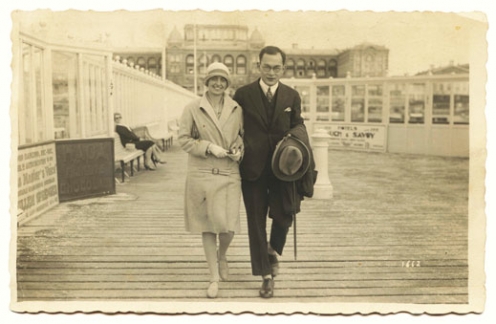Encounter
Eida Schepers (Winschoten, The Netherlands, August 28th 1906) and Dr Tan Sin Hok, MSc (Tjipadang, West Java, March 28th 1902) meet at a student party in The Hague on February 18th 1928. Hok has finished his doctoral thesis on mining engineering with distinction on October 5th 1927 and is currently writing an article on fossil micropalaeontology in Bonn, Germany. The Dutch educational system that was introduced in the colonies has allowed him to finish the Europeesche Lagere School (ELS) in Tjiandoer and the Koning Willem III School in Batavia and subsequently to study mining engineering in Delft, The Netherlands. Eida has been reading Dutch Language and Literature at Leiden University since September 1926.
Departure
On May 26th 1928, a few months after their meeting, Eida en Hok get engaged. Eida terminates her studies and takes courses at the Koloniale School in The Hague in order to prepare for her new life: the Indies. The two get married on April 16th 1929 and leave for Hok’s native Java in the Netherlands Indies only days later. It is not an uncommon destination for Eida’s family. Apart from a Goudsmit cousin and another two Schepers cousins, as well as her own sister Anneke (1905-1982), who had already left in January 1929, Emma, her younger sister (1908-2004), would eventually join her in the Indies too. Eida is the only member of the family to enter into a cross-cultural marriage with an Indo-Chinese.
Bandung
Eida and Hok settle in Bandung, where Hok holds a position as mining engineer and palaeontologist at the Dutch Colonial Government. He declines a job offer by the Bataafsche Petroleum Maatschappij (Shell) because it would prevent him from publishing under his own name. Eida runs the home and learns to deal with her new environment and the coming and going of servants – without speaking the language, at first. With time, she becomes actively involved in women’s rights movements.
Contacting Holland
Every week a letter is sent to Eida’s parents in the Hague, via mail boat initially and via airmail as of 1933. Usually, Eida writes about ¾ of a letter and Hok what remains. They read each other’s words and add comments. Hok finds it most inspiring to communicate with his culturally educated in-laws. His excursions on economy, scientific research, politics and his position vis-à-vis the Chinese in the Indies are clearly addressed to “Father”, i.e. Dr Menno Schepers (1875-1948), who teaches classics at the Haganum College in the Hague.
Children
Eida gives birth to four children. Elza, however, who is born after both a complicated pregnancy and birth, lives for only six hours. Then come Axel (1932), Lisa (1935) and Gijsbert (1942). The children receive Chinese proper and generation names besides their European first names.
The Japanese War and the Bersiap period: the end of the Netherlands Indies
One night in 1943, one and a half year after the outbreak of the Japanese war, the Kempetai, the Japanese Secret Police, arrest the family in their beds, presumably because Hok is a Freemason. During his captivity in Tjimahi, Hok decides that he should ‘return’ to ancestral China with his family and leave “Indonesia to the Indonesians”.
After the Japanese capitulation in August 1945, Hok is reunited with Eida and the children. Three months later, during the Bersiap, he is killed by a gang of Pemoeda’s who have come to raid his home. Eida’s right arm is badly wounded, which gives her the privilege to fly back to Holland with the Skymaster together with her three children. She arrives in Amsterdam on April 16th 1946.

